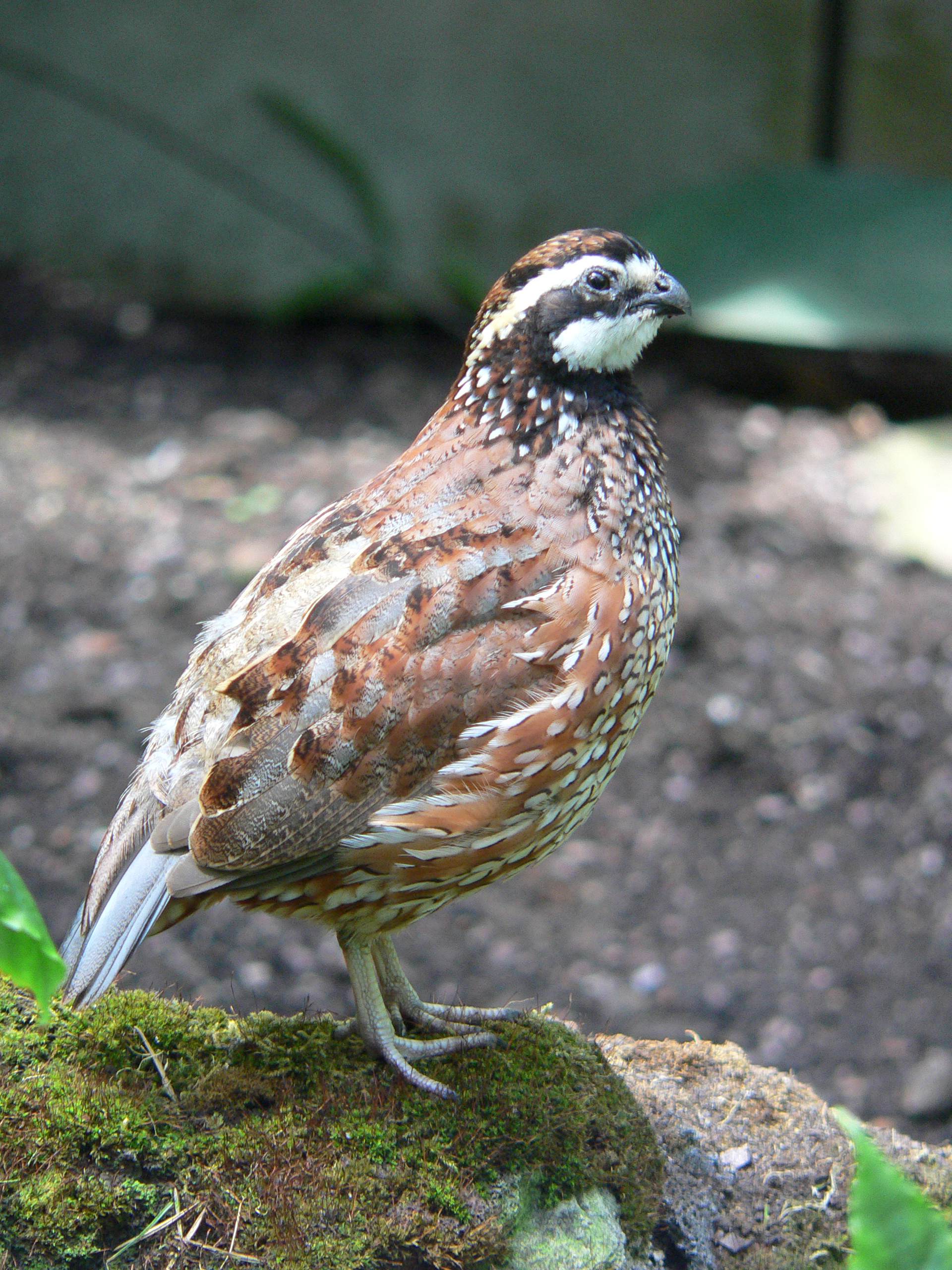- Bobwhite Quail
Taxobox
name = Northern Bobwhite

image_width = 200px
image_caption = Adult male
status = NT
status_system = iucn3.1
regnum =Animal ia
phylum =Chordata
classis =Aves
subclassis =Neornithes
infraclassis =Neognathae
superordo =Galloanserae
ordo =Galliformes
familia = Odontophoridae
genus = "Colinus "
species = "C. virginianus"
binomial = "Colinus virginianus"
binomial_authority = (Linnaeus, 1758)
subdivision_ranks =Subspecies
subdivision = About 2 dozenThe Northern Bobwhite, Virginia Quail or (in its home range) Bobwhite Quail ("Colinus virginianus") is a ground-dwelling
bird native toNorth America and northernCentral America and theCaribbean . It is a member of the group of species known as New World quails (Odontophoridae ). They were initially placed with the Old World quails in the pheasant family (Phasianidae ), but are not particularly closely related. The name "bobwhite" derives from its characteristic whistling call.Description
Northern Bobwhites are distinguished by a dark cap stripe behind the eye along the head, black in males and brown in females. The area in between is white on males and yellow-brown on females. The body is brown, speckled in places with black or white on both sexes, and average weight is five to six ounces (145-200 grams).
The Northern Bobwhite's song is a rising, clear whistle, "bob-White!" or "bob-bob-White!" The call is most often given by males in spring and summertime. Other vocalizations include a range of squeaky whistles.
[http://www.mbr-pwrc.usgs.gov/id/framlst/Song/h2890so.mp3 Virginia Quail's "bob-White!" song]
Ecology
This
fowl primarily inhabits areas of early successional growth dominated by various species of pine,hardwood , woody, andherb aceous growth. However, quail habitat varies greatly throughout its range which extends fromMexico east toFlorida and north into theUpper Midwest and Northeast. In the southern U.S.,pearl millet has been identified as a preferred food source for Bobwhite Quail.It forms what are known as "coveys", groups of five to 30 birds, during the non-breeding season (roughly October-April). During the breeding season, typically beginning in mid-April, the Bobwhite coveys dissolve. Social pairs are typically formed between individuals of unknown relationship. These social pairings potentially result in the formation of a mate bond and subsequent female fertilization and egg formation. Eggs are laid at a rate of approximately 1 per day, and they hatch after 23 days. Eggs are normally white in color with a more pointed end than normal
chicken eggs.Both males and females can incubate nests, with most nests predominantly incubated by females. If the first clutch of eggs is unsuccessful, a breeding pair (may be the same pair or a different pair as that which led to the previous nesting attempt) will attempt to lay, incubate, and hatch additional clutches. If the clutch is successful, chicks are
precocial and will leave the nest approximately 24 hours following hatching. The breeding season continues until mid-October, and successful nesters (females) can potentially lay, incubate, and hatch up to 3 clutches.The Bobwhite Quail is a popular and economically important
gamebird , particularly in theUS Southern States . It is the official game bird of the U.S. States ofTennessee , Georgia, andWashington . Habitat degradation threatens wild populations, so it is propagated in captivity in large numbers for release on hunting preserves or natural areas as required by US wildlife agencies. It is moderately resilient to hunting pressure, and locally can disappear entirely fromoverhunting , as has occurred time and again [E.g. Strong (1898)] . It is also found in many aviaries and is on display in some zoos.If a bobwhite quail is stationary, it is nearly impossible to see (in a forest). This coat of camo is important because quail are heavily preyed upon. Foxes, coyotes, racoons, possums, hawks, owls, and humans eat quail.
Footnotes
References
*|year=2004|id=54207|title=Colinus virginianus|downloaded=11 May 2006 Database entry includes a brief justification of why this species is near threatened
* (1989): North Greenfield, Wis.. "Wilson Bull." 10(5): 70. [http://elibrary.unm.edu/sora/Wilson/DJVU/v010n05/P0070-P0070.djvu DjVu fulltext] [http://elibrary.unm.edu/sora/Wilson/v010n05/p0070-p0070.pdf PDF fulltext]External links
* [http://www.itis.usda.gov/servlet/SingleRpt/SingleRpt?search_topic=TSN&search_value=175863 ITIS Standard Report Page: Colinus virginianus taxonomic details (includes subspecies) ]
* [http://www.fcps.k12.va.us/StratfordLandingES/Ecology/mpages/northern_bobwhite.htm Northern Bobwhite] Additional information, pictures, sound and video clips
* [http://www.gamebird.com/bobwhite.html Aspects of the natural history, economic importance, and propagation of the bobwhite quail.]
* [http://www.birds.cornell.edu/AllAboutBirds/BirdGuide/Northern_Bobwhite.html Cornell Lab of Ornithology - Northern Bobwhite]
* [http://www.gbwf.org/quail/bobwhite.html gbwf.org - Northern Bobwhite]
* [http://www.sdakotabirds.com/species/northern_bobwhite_info.htm South Dakota Birds and Birding - Northern Bobwhite]
* [http://www.mbr-pwrc.usgs.gov/id/framlst/i2890id.html USGS Patuxent Bird Identification InfoCenter - Northern Bobwhtie]
* [http://www.bird-stamps.org/cspecies/3701000.htm Stamps]
* [http://www.qu.org/content/habitat/nbci/index.cfm The Northern Bobwhite Conservation Initiative]
Wikimedia Foundation. 2010.
